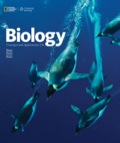
Concept explainers
Introduction:
The nutrients which are required in large amount are known as macronutrients whereas substances which are required in trace amount are known as micronutrients. A plant needs around sixteen nutrients for growth and development.
Answer to Problem 1SQ
Correct answer:
Carbon, hydrogen, and oxygen are the macronutrients and required elements for the plant. Hence, the correct answer is option f.
Explanation of Solution
Reason for correct answer:
Optionf. is given as, “both a and d.”
Carbon, hydrogen, and oxygen are present in abundance in the atmosphere. Carbon is obtained from carbon dioxide, whereas hydrogen is obtained from water by the plants. These nutrients are important for plant’s growth and are required in bulk amount for survival. These elements along with other macronutrients form above 0.5% of plant’s dry weight.
Reason for incorrect answer:
Option a. is given as, “macronutrients.”
Apart from carbon, oxygen, and hydrogen, other macronutrients such as nitrogen, phosphorus, and sulfur are also necessary for plant’s growth and survival. Hence, option a. is incorrect.
Option b. is given as, “micronutrients.”
Chlorine, iron, boron, manganese and many other elements are required by the plant in trace amount and are called micronutrients. Carbon, oxygen, and hydrogen are required in large quantity by the plant and are called macronutrients. Hence, option b. is incorrect.
Option c. is given as, “trace elements.”
Micronutrients such as boron, manganese, and others are also known as trace elements. Carbon, hydrogen, and oxygen are not micronutrients and cannot be called as trace elements. Hence, option c. is incorrect.
Option d. is given as, “required elements.”
Various elements are required by the plants in bulk or trace quantities. The required elements are not restricted to carbon, oxygen, and hydrogen. Other elements such as nitrogen, boron, manganese, and many more are also required by the plant for growth and development. Hence, option d. is incorrect.
Optione. is given as, “both a and b.”
Carbon, hydrogen, and oxygen are required in bulk amount. These elements are called macronutrients. Elements required in low amounts are micronutrients. Carbon, hydrogen, and oxygen cannot be micronutrients. Hence, option e. is incorrect
Hence, the options a, b, c, d, and e are incorrect
Therefore, the given option “both a and d” is correct. Thus, the correct option is f.
Want to see more full solutions like this?
Chapter 26 Solutions
EBK BIOLOGY: CONCEPTS AND APPLICATIONS
- Using quail and chick embryos, quail-specific antibody and fluorescent tissue-specific antibodies, design an experiment where you investigate the tissues the cranial neural crest can give rise to. What are four derivatives of the cranial neural crest that you expect to see in the resulting chimeric embryos?arrow_forwardDoes the neural crest have to undergo epithelial to mesenchymal transition prior to migration through the developing embryo? Does the neural crest differentiate into different cell types based on their axial position along the anterior and posterior axis?arrow_forwardUsing quail and chicken embryos, what kind of experiment would you conduct to test if rib forming somites have their axial identity specified before segmentation? How do we know this phenotype is due to axial identity being specified before segmentation and not due to our experimental method?arrow_forward
- 8. Aerobic respiration of a 5 mM solution of tripeptide that is composed of the following three amino acids; alanine, leucine and isoleucine. Alanine breaks down to pyruvate, leucine breaks down to Acetyl-CoA and isoleucine breaks down to succinyl-CoA. Alanine NADH FADH2 OP ATP SLP ATP Total ATP Leucine Isoleucine Totals Show your work using dimensional analysis here: 4arrow_forward9. Aerobic respiration of one lipid molecule. The lipid is composed of one glycerol molecule connected to two fatty acid tails. One fatty acid is 12 carbons long and the other fatty acid is 18 carbons long in the figure below. Use the information below to determine how much ATP will be produced from the glycerol part of the lipid. Then, in part B, determine how much ATP is produced from the 2 fatty acids of the lipid. Finally put the NADH and ATP yields together from the glycerol and fatty acids (part A and B) to determine your total number of ATP produced per lipid. Assume no other carbon source is available. fatty acids glycerol 18 carbons 12 carbons 0=arrow_forwardinfluences of environment on the phenotype.arrow_forward
- What is the difference between codominance and phenotypic plasticity?arrow_forwardExplain the differences between polygeny and pleiotropy,arrow_forwardIf using animals in medical experiments could save human lives, is it ethical to do so? In your answer, apply at least one ethical theory in support of your position.arrow_forward
- You aim to test the hypothesis that the Tbx4 and Tbx5 genes inhibit each other's expression during limb development. With access to chicken embryos and viruses capable of overexpressing Tbx4 and Tbx5, describe an experiment to investigate whether these genes suppress each other's expression in the limb buds. What results would you expect if they do repress each other? What results would you expect if they do not repress each other?arrow_forwardYou decide to delete Fgf4 and Fgf8 specifically in the limb bud. Explain why you would not knock out these genes in the entire embryo instead.arrow_forwardYou implant an FGF10-coated bead into the anterior flank of a chicken embryo, directly below the level of the wing bud. What is the phenotype of the resulting ectopic limb? Briefly describe the expected expression domains of 1) Shh, 2) Tbx4, and 3) Tbx5 in the resulting ectopic limb bud.arrow_forward
 Biology: The Unity and Diversity of Life (MindTap...BiologyISBN:9781305073951Author:Cecie Starr, Ralph Taggart, Christine Evers, Lisa StarrPublisher:Cengage Learning
Biology: The Unity and Diversity of Life (MindTap...BiologyISBN:9781305073951Author:Cecie Starr, Ralph Taggart, Christine Evers, Lisa StarrPublisher:Cengage Learning Concepts of BiologyBiologyISBN:9781938168116Author:Samantha Fowler, Rebecca Roush, James WisePublisher:OpenStax CollegeEssentials of Pharmacology for Health ProfessionsNursingISBN:9781305441620Author:WOODROWPublisher:Cengage
Concepts of BiologyBiologyISBN:9781938168116Author:Samantha Fowler, Rebecca Roush, James WisePublisher:OpenStax CollegeEssentials of Pharmacology for Health ProfessionsNursingISBN:9781305441620Author:WOODROWPublisher:Cengage





